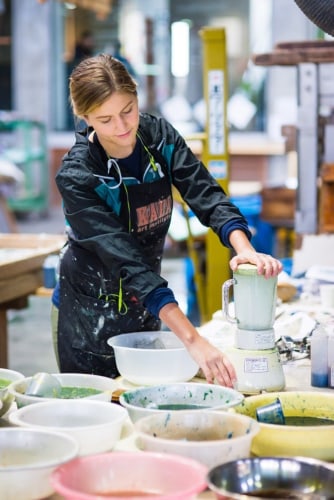
Richelle Gribble, blending and coloring raw kozo fiber for pulp painting at the Awagami Factory (Naoki Isoda / Awagami Factory)
Photo courtesy of The Atlantic
We’ve seen artist-in-residence programs in a number of the towns we’ve visited. The first was in Eastport, Maine, where we ran into Richelle Gribble, a young artist based in Los Angeles, whom I consider an resident-artist extraordinaire. Over the past three and a half years, Richelle (as I’ll refer to her) has been an artist-in-residence in 15 different programs around the world, from a biosphere in Arizona to a ranch in Wyoming to the Arctic Circle in northern Svalbard, a Norwegian archipelago. I’m not kidding about the Arctic Circle.
Richelle is an accomplished artist with pages and pages of a CV that includes solo and select group exhibitions, awards and fellowships, public collections, curated projects, public speaking engagements, memberships in committees and organizations, and publications. She is 28 years old.
When I was back in touch with Richelle recently, she had just returned from the Arctic Circle. I was interested in talking with her about the idea of residencies, how she approaches her time on location, what artists’ perspectives bring to a town, and what the experience brings to an artist.
We decided to talk about her residency in Japan, with its famously complicated culture, and where my husband, Jim, and I had lived for about two years back in the late 1980s, when our children were young.
* * *
Here’s what we talked about: Along our own travels around the country for American Futures and Our Towns, many people have asked Jim and me how we start our reporting when we visit a town. It’s a fair question, and our answer is that we do some research ahead of time—and then once on scene, we spend a day or two talking to the “usual suspects” (journalists, school administrators, city-government officials, business people, librarians, people in the arts, etc.) and ask them about the interesting and compelling stories and issues in town, and about the people we should meet. Then we head out to connect with as many people in as many on-the-ground situations as possible.
I was interested in how this process worked for an artist-in-residence, so I asked Richelle the same questions: What does she do upon arrival? How does she build a sense of the place? How does that begin to translate into the art she makes? Her answers resonated with me.
...